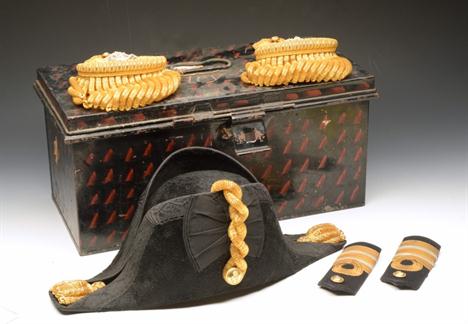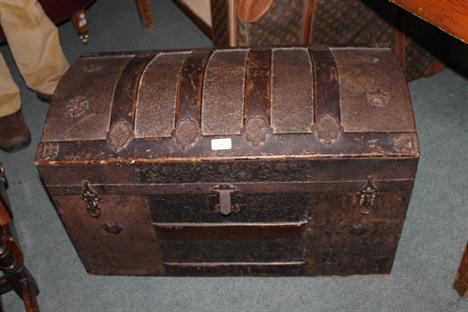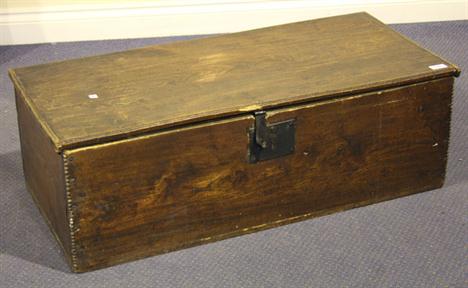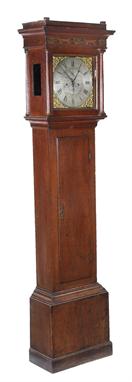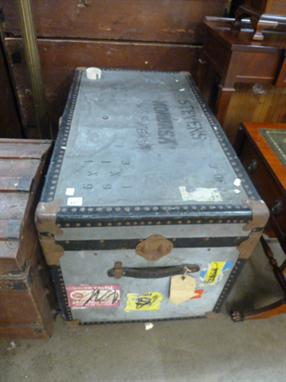66969 Preisdatenbank Los(e) gefunden, die Ihrer Suche entsprechen
66969 Lose gefunden, die zu Ihrer Suche passen. Abonnieren Sie die Preisdatenbank, um sofortigen Zugriff auf alle Dienstleistungen der Preisdatenbank zu haben.
Preisdatenbank abonnieren- Liste
- Galerie
-
66969 Los(e)/Seite
A MacFarlane Lang & Co. Limited tinplate biscuit tin in the form of an anvil, chromolithographed to one side with "Shoeing the bay mare" AFTER LANDSEER, to the opposing side "The Village Blacksmith", a tinplate model of a small cabin trunk initialled "HSC" and a W & S Hull "White Standard Confections" tinplate biscuit tin in the form of a red brick and gabled house with two chimneys, bearing Registration No. 421634 (3) CONDITION REPORTS All with quite heavy wear, scuffs, scratches, rusting and pitting, losses to decoration, some denting and mis-shaping. Cottage tin has various holes to edges where fitments may originally have been attached. Printed pictures quite deteriorated in places to all items.
A 19th Century mahogany long case clock, the arched hood with dentil swan neck pediment with applied brass mount centred by a brass finial over a fretwork frieze, glazed door flanked by gilt metal Corinthian fluted pilasters over an arched trunk door, flanked by three quarter fluted pilasters on a fielded panel fronted base on ogee bracket feet, the silvered glazed and arched dial with Roman and Arabic numerals, subsidiary seconds, date aperture inscribed "Walter Crichton, Haddington", the eight day movement striking on a bell, 230 cm high, with two weights, pendulum and key
A Chinese Yixing stoneware teapot and cover, probably late 19th Century, the trunk moulded body decorated in relief with a blossoming prunus branch, the handle formed as entwined bamboo, impressed seal mark to base and incised two character mark to cover interior, length approx 18.5cm (chips to lid), together with another Yixing stoneware teapot of pumpkin form with blue enamelled Buddhistic lion decoration, impressed mark to base (chips).
A Home Guard 1937 pattern battledress blouse, size No. 13, with SX4 and Home Guard printed titles, together with further items of uniform, four regimental ties, two Scottish broadsword hilt liners, various berets, including French Airborne, three printed flags etc, in a canvas covered trunk.
A fine 20th century copy of an early 18th century burr walnut barometer, the dial signed Tompion, London. Surmounted by a gilt-brass thistle urn for reservoir protection, on an elaborate plinth to a short trunk applied with a turned Doric pilaster, supported on a pair of brass-mounted freestanding Doric columns and bow-fronted base section, the two-piece silvered dial signed in a cursive script and set with weather predictions and twin recording hands operated via a pair of rack and pinion knobs set below the glazed aperture, a circular calendar dial set to the lower section of the base with twin silvered scales for month and date, 104cm high.
A George III oak eight-day longcase clock with unusual chapter ring, Charles and Edward Gillet, Manchester, late 18th century, the four pillar movement with anchor escapement and hour striking on a bell controlled by locking pins fitted to the strike great wheel, the 12 inch square brass dial with subsidiary seconds and calendar dials to the symmetrical scroll engraved centre within applied Roman numeral chapter ring with Arabic five minutes to outer track and unusual half hour markers which comprise of letters to form the name JOSEPH JEPSON the lower edge signed Cha`s & Edw. Gillet, Manchester, the angles with rococo scroll cast spandrels, the case with ogee shaped caddy surmount above cavetto moulded cornice, foliate fretwork frieze and columns flanking the square hood door, the trunk with shaped-top mahogany crossbanded caddy-moulded door flanked by quarter columns to front angles, on raised-panel fronted plinth base with ogee bracket feet, 217cm (85.5ins) high. The partnership between Charles and Edward Gillet is recorded in Baillie, G.H. Watchmakers & Clockmakers of the World as working circa 1790-1800. The name formed from letters positioned as half hour markers is highly unusual and probably spells out the name of the original owner.
An unusual scumbled pine small short duration longcase timepiece with alarm, the dial signed for John May, 18th century, the single-handed movement the with tic-tac escapement and thirteen inch bob pendulum to the three-wheel going train set between narrow frontplate and central movement strip united by two substantial pillars extended at the rear to allow for a further plate to carry the alarm mechanism, with a 7 inch square brass dial with silvered alarm disc and blued steel hand to the matted centre within silvered Roman numeral chapter ring with spear half hour markers and signed John May to lower margin, the angles with applied winged cherub head spandrels, in pine and elm case painted/scumbled to resemble oak with moulded cornice, plain frieze and square glazed door to hood above concave throat moulding and slender caddy-moulded door to trunk, on conforming plinth base with moulded skirt, (with restoration and possible alteration), 193cm (76ins) high. A John May is recorded in Loomes, Brian, Watchmakers & Clockmakers of the World, Volume 2 as working in Bath circa 1740.
An Edwardian inlaid mahogany quarter chiming eight-day longcase clock, unsigned, early 20th century, the four pillar triple train movement chiming the quarters on a choice of either eight bells or four gongs and striking the hour on a further gong, the 12.5 inch brass break-arch dial with subsidiary seconds dial to the matted centre within applied silvered Roman numeral chapter ring with fleur-de-lys half hour markers and Arabic five minutes, the angles with winged cherub head and scroll cast spandrels and with chime selection switch at three o`clock, the arch with subsidiary CHIME/SILENT selection dial flanked by scroll cast mounts, the swan neck pedimented case with foliate inlay above brass Corinthian pillars and rectangular scroll pierced sound frets to sides, the trunk with shallow-arch door decorated with a drapery swag above elaborate tall foliate scroll marquetry cartouche within satinwood banded surround, on plinth base with conforming marquetry panel and moulded skirt incorporating shaped apron and bracket feet, 234cm (92ins) high.
A George III oak eight-day longcase clock, George Hewett, Martley, late 18th century, the four pillar rack and bell striking movement with 12 inch square brass dial with subsidiary seconds dial and signed signed George Hewett, Martley to the scroll engraved silvered centre within applied Roman numeral chapter ring with concentric calendar to the inner track and Arabic five minutes, the angles with scroll cast spandrels, in a case with cavetto moulded cornice and three-quarter columns to hood above rectangular caddy moulded door to trunk, on plain plinth base with moulded skirt, 198cm (78ins) high.
An oak eight-day longcase clock, the dial bearing signature for Springer, Stockport, 18th century and later, now with 19th century four pillar rack and bell striking movement fitted to an 11 inch square brass dial with ring turned calendar aperture to the foliate scroll engraved matted centre within applied Roman numeral chapter ring with fleur-de-lys half hour markers and bearing signature Springer, STOCKPORT to lower edge, the angles with female mask and scroll cast spandrels, now in a case with ogee moulded caddy above conforming cornice, blind fret fronted frieze and turned columns flanking dial, the trunk with shaped top door over plain plinth base with moulded skirt incorporating bracket feet, 206cm (81inches) high.
A walnut eight-day longcase clock, mid 18th century and later, the 19th century four pillar rack and bell striking movement with 12 inch white painted Roman numeral break-arch dial with subsidiary calendar and seconds dials and bearing signature Leddgeer, Norwich to centre, with game bird painted spandrels and conforming landscape with hunstman and hound to arch, now in an earlier case with later swan neck crest above moulded cornice and three-quarter columns to hood, the trunk with break-arch crossbanded door, on conforming plinth base with moulded skirt, 226cm (89ins) high.
A French gilt brass mounted walnut miniature longcase clock, Maple and Co. Paris, circa 1900, the eight-day bell striking movement stamped MAPLE & Co. PARIS within rectangular cartouche to backplate, the circular cream enamel dial painted to simulate a thirteen piece Roman numeral dial with Arabic five minutes to outer track and with glazed convex bezel, the case with foliate scroll crest and conforming side mounts terminating with stylised dolphins to hood section above glazed waisted trunk with further mounts to angles, on panel fronted plinth base with scroll cast feet, 49cm (19.25ins) high; with non original a gilt metal mounted oak wall bracket of ogee outline with cast mounts to angles and base, 19cm (7.5ins) high, the clock and wall bracket 58cm (22.75ins) high overall.
A Victorian oak mercury stick barometer, William Christie, Sterling, late 19th century, with large bore tube and bevel glazed twin canted bone vernier scales calibrated in Barometric inches and annotated with Admiral Fitzroy`s observations the first labelled 9 A.M. YESTERDAY, the other 9 A.M. TODAY and with signature Wm. CHRISTIE, STIRLING to upper margin, the case with cushion moulded cornice and twin bone vernier adjustment screws to throat above plain trunk and square cistern with moulded cover to base, 98cm high.
A Victorian mother of pearl inlaid rosewood mercury wheel barometer, Maspoli Monti and Co., Sandwich, mid 19th century, the 8 inch leafy scroll cartouche centred circular silvered register calibrated in barometric inches and with the usual observations beneath tapered trunk with convex glazed mercury Fahrenheit thermometer and hygrometer to the swan neck pediment, the square base with spirit level signed Maspoli Monti and Co. Sandwich, the case with fine mother of pearl scroll inlaid borders to fascia, 97cm high.
A Victorian oak stick barometer, J.H. Steward, London, late 19th century, with cavetto cornice above glazed twin canted ivory vernier scales calibrated in barometric inches one labelled 10 A.M. YESTERDAY, the other 10 A.M. TODAY and signed J.H. STEWARD, 54 CORNHILL & 406 STRAND, LONDON across upper margin, the case with twin vernier adjustment screws to throat above slender trunk and disc turned cover to the cistern with level adjustment screw to underside, 93cm high.
A Victorian rosewood mercury wheel barometer, Belotti and Gugeri, London, mid 19th century, the 6 inch star centred circular silvered register signed Belotti & Gugeri, LONDON within scale calibrated in barometric inches and with the usual observations beneath tapered trunk with convex glazed mercury Fahrenheit thermometer and swan neck pediment, the square base with cavetto moulded underside, 97cm high.
A 19th century mahogany long case clock, the swan neck pediment over crossbanded and burr frieze, arched glazed door, painted face, four season spandrels, mounted by escalating Adam & Eve, Roman numerals with subsidiary dial flanked by boxwood strung Doric columns, boxwood strung trunk door and stepped base, anchor escapement with striking bell, 223cm high
-
66969 Los(e)/Seite



















